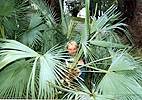 Lettre De France
Lettre De France
Alain Moinié sends a picture postcard
from the Cote d'Azur.
Alain Moinié, Pep. J. Rey, Domaine de la Pascalette, 83250
La Londe les Maures, France
Chamaerops No. 1, published online 23-11-2002
[an error occurred while processing the directive]

C'est moi! Down on my knees for a closer look at
a suckering Brahea species (dulcis?).
Dear Editor,
I was very pleased to learn of the formation of
'The European Palm Society' and I am very happy to join. As the
magazine is to be called "Chamaerops" I thought I'd write
you a letter and tell you a few things about the European Fan Palm
here on the French Riviera.
No one knows whether it is indigenous or introduced.
Some people claim that it has always existed in the wild state in
the vicinity of Villefranche-sur-mer, near the Italian border. Axel
Robertson-Proschovsky, perhaps the very first French palm enthusiast
(he planted over 100 species of palm on his property) said in 'La
revue horticole' 100 years ago, that Chamaerops has always been
natural in this area. However, there is no fossil evidence for this,
either seed or pollen, in the archaeological layers.
Nowadays it is widely planted, both in public and
private gardens. Next to the nursery where I work is the abandoned
and neglected garden of a big country house. There are 9 species
of palms growing there completely unattended: Butia capitata, Phoenix
reclinata, P. dactylifera, P. canariensis, Jubaea chilensis, Brahea
armata, B. edulis, Sabal minor and Chamaerops humilis. Interestingly,
the Brahea, Butia, Phoenix and Chamaerops have naturalised. There
is a Brahea armata for instance, still young, but with already quite
a big trunk, growing at the foot of a big clump of Chamaerops which
leans over its head. This poor Brahea has its leaves completely
stuck up against the trunk of the Chamaerops, but it looks perfectly
happy and healthy anyway with beautiful, almost white leaves.
The Chamaerops are in such great numbers that they
cover large parts of the garden, growing in grassy areas or under
Quercus ilex, Pinus pinea and Acacia dealbata. They seem to be trying
to colonize the entire garden and have even begun to invade our
nursery, which borders it. They are the wild form, small and bushy,
with sometimes a small emergent trunk. The leaves differ greatly
from plant to plant, small and compact to large; glaucous to silver
or green. I am sure that animals and birds (probably foxes, thrushes,
magpies and blackbirds) help them to spread, by eating the fleshy
fruits, and then evacuating the seeds at some distance away. The
plants remain small surely because of lack of water; no artificial
irrigation takes place any more and the plants must rely on the
rain. Summer months especially are rather dry in the Mediterranean
area.
I work with a Moroccan who knows my interest in
palms. He tells me that in his country, during November and December,
the young people go into the hills in search of Chamaerops. They
choose the biggest ones, then take out the main trunk, which they
peel like a leek, to eat the heart. He also said that people eat
the fruits (how can they eat something that smells so bad?!) and
use the leaves to make hats, baskets and ropes, and the fibre for
mattresses.
The naturalization of Chamaerops, and palms generally,
is interesting for two reasons: firstly, it proves that freezes
are not strong enough, or last long enough to kill even the vulnerable
young plants. (A cold spell occurs every 20/30 years. During the
85/86 winter the minimum temperature was minus 9°C, but the
north-west wind called 'mistral' has devastating effects in creating
violent masses of cold air).
Secondly, if we imagine that the human race should
disappear from the face of the earth for some reason, nature would
certainly recover the areas lost to human pressure. We would probably
have hills covered with palms, a new landscape, and even perhaps
the evolution of some new species after a long time. A pity we wouldn't
be here to enjoy it.
Well I had better finish this letter now. I wish
you success with the new society, and now you know a little bit
more about your emblem.
A bientot,
Alain Moinié

Readers Comments:
(No comments yet. Be the first to add a comment to
this article!)
|
 |
[an error occurred while processing the directive]
|
